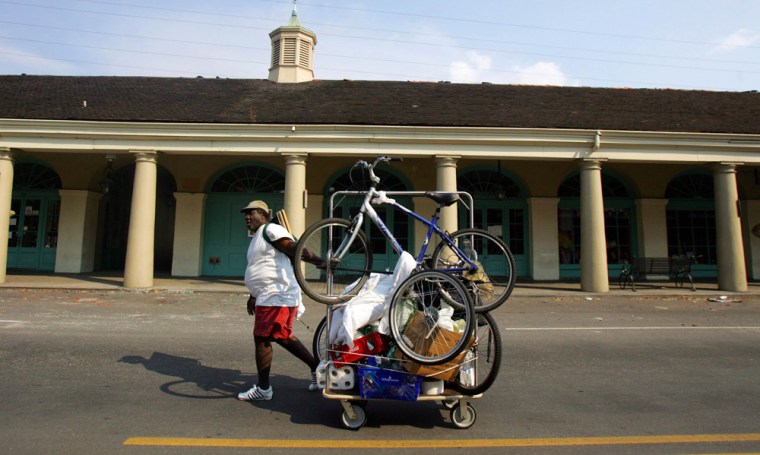The 21st century was swept away here. The winds and the floods and the disasters that followed took it.
Some strange, more primitive time took its place, amid the useless computers and cars of the modern world. Those stranded were left behind to forage for food and water, share what little they have with neighbors, and find somewhere safe before night falls.
“Say goodbye to the Jetsons,” Aaron Broussard, president of next-door Jefferson Parish, told residents on the all-night radio station and news lifeline. “We’re back to the Flintstones.”
Life is hand-to-mouth, if it continues at all. On Rampart Street on the edge of the French Quarter, a wooden handcart became a funeral bier. An elderly man’s dead body was left atop it, wrapped in a shroud made from a child’s bedsheet and tied with twine.
Still, many survive, emerging from their homes determined to find ways to stay alive. A shopping cart is a wonderful tool — mobile, lightweight, the basket high enough to stay above the foul-smelling puddles. A woman used one to move her family’s belongings to a ramshackle sidewalk camp. Then her children turned it into a jungle gym.
On the edge of the very poor Ninth Ward along the Intracoastal Waterway, a man and women wade stomach-deep, pushing a rowboat to a higher, drier stretch of grass. They scavenge for whatever might be useful — a bucket that won’t leak, a solid piece of wood, tools.
Lessons in how to live without
A block or two away, where the water drops to knee-deep, to puddles, and then to dry land, the scene recalls a movie set of a war zone. Abandoned buses line a larger avenue, one every few blocks. A building burned to the ground smolders. A charred car, its front doors gone, sits in an intersection.
“We’ve all got guns,” said Katha Fields, who lives down the street. Weeks ago, when this city was a place of tourists and jazz and jambalaya, she was a tour guide. Now, she and her neighbors gather at dusk, weapons at hand, and keep watch.
They’re all getting a lesson in how to live without.
They learn what darkness means when there are no lights. Suddenly, candles are a lot more than romantic. They learn what hunger means when there’s no refrigerator, no microwave, no stove. They learn what thirst means when water is tainted from refuse, sewage and worse.
One woman, 76-year-old Carolyn Knack, cleaned her dentures in dishwashing liquid. An elderly man went to the banks of the Mississippi to scrub his clothes.
Taking what's needed
Looting takes on many different names: borrowing, requisitioning, commandeering. Maybe an older, anthropological term works best — hunting and gathering.
“A looter is not someone who takes food or water and what people need,” said a New Orleans police officer whose unit set up in an abandoned downtown hotel and rode out the post-Katrina chaos.
He and his crew took what they needed to keep doing their jobs. “We requisitioned a lot of items. Basically we find a store that had been looted and we go and salvage what we could” — water, candy bars, gasoline.
He wouldn’t give his name because he’d be fired, he said.
Television images of looters raiding Wal-Mart for guns — or neighbors’ tales of people pillaging houses — drew disgust and condemnation from virtually everyone. But it wasn’t quite as simple as the pictures seemed. Some stole; some helped.
Stolen boats were used to rescue people from their homes. Stolen cars moved them across the city to dry land. Stolen food, water and clothes supplied the basic essentials.
“They was just stealing stuff to get by,” said Ebony Morgan, 23, a single mom catching a bus of evacuees out with her twin 2-year-olds, Kristin and Eitan. “They was just giving it all away.”
Struggling to maintain tradition
Still, not all is desperation.
On a third-floor balcony in the French Quarter, a dozen neighbors have come together, toting water from the Mississippi to flush their toilets, sharing what food they’ve got left on a stove that still has gas, keeping their homes safe and dry.
“I’ve got a pear and an orange left,” said Jill Sanders, an artist and paralegal who is better known around the neighborhood as Jelly Sandwich.
A bar or two stays open. “I go down to Molly’s in the evenings. I put on makeup and something nice. It cheers people up” — and it raises her own spirits, she said.
Around the corner, a few dozen staffers at a hotel they’ve kept open held a Labor Day barbecue. Tradition is tradition.
Some holdouts here believe they’ll be just fine if they could only get water, or power, or phone service. None of it is coming soon, officials say.
So far, people can find shelter and food to scavenge, but not forever. In their place are many, many threats: disease in the dirty floodwaters. Fires in wet homes, and overtaxed fire crews that can’t respond. Lawlessness.
Eventually, officials say, they’ve got to evacuate everybody, and start over again.
